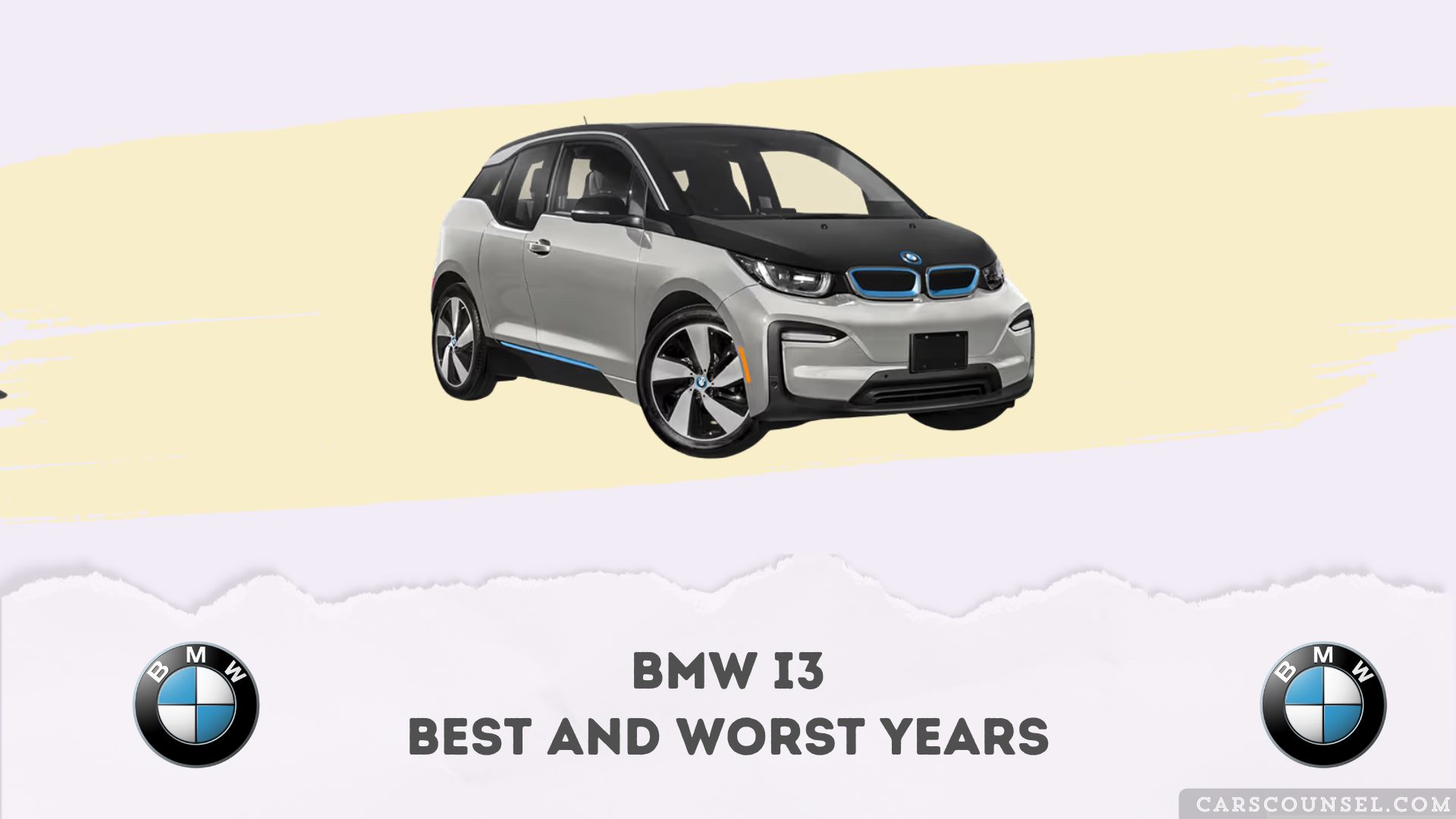While the BMW i3 is praised for its innovative design, early models faced reliability issues. You’ll find that later models, like those from 2017 and beyond, offer improved reliability and better value retention. In contrast, pre-2018 models were plagued by drive-bearing and electrical system failures.
As you consider purchasing a used i3, understanding these differences is vital to making a smart investment. What makes these later models more desirable?

Quick Navigation
Key Takeaways
- The 2017 models resolved early production issues, enhancing reliability.
- 2018 models faced recalls due to faulty circuit boards.
- Pre-2018 models had common drive-bearing failures.
- 2019-21 i3s hold value well and are solid used car choices.
- Post-2017 models are more dependable compared to earlier versions.
Overview of the BMW I3
As you consider the BMW i3, you’ll notice it’s a car that stands out due to its unique features and design.
The BMW i3 is a funky-looking electric car that debuted ahead of its time, offering an odd 2+2-door configuration and eco-conscious interior panels made from hemp-reinforced plastics.
Its carbon-fiber passenger cell sits atop an aluminum skateboard platform that houses the suspension, motor, battery, and, in the REx version, a small two-cylinder petrol engine.
This setup powers the rear wheels, making the i3 both visually distinctive and innovative in structure.
Powertrain Variations
As you delve into the powertrain variations of the BMW i3, you’ll find that it’s equipped with a single electric motor driving the rear wheels, providing impressive torque.
The i3s offer a power boost, delivering 181 horsepower compared to the standard model’s 170 horsepower.
Additionally, the Range Extender (Rex) version includes a small engine similar to those used in BMW scooters, which adds about 70-80 miles of range to the car’s electric capability.
Powertrain Variations
In the BMW i3 lineup, how do you choose the right powertrain to suit your needs?
It depends on your preferences for range, performance, and handling.
Some key options include:
- Pure electric model with 170 hp.
- i3s variant with 181 hp and firmer suspension.
- Range Extender (REx) version using a small engine to boost range.
- Models offered with different battery sizes, affecting range.
- The i3s had wider wheels and improved handling compared to the standard i3.
Electric Motor
The BMW i3’s electric motor is a key component of its powertrain variations, offering different levels of performance across its models.
You’ll notice the motor drives the rear wheels, providing a nimble feel typical of electric vehicles.
The standard i3 delivers 170-hp, while the i3s variant offers slightly more power.
Both models use a hybrid synchronous motor, ensuring efficient energy use and good acceleration.
This setup makes the i3 well-suited for city driving, thanks to its responsive torque delivery.
Range Extender
BMW’s innovative Range Extender (REx) model offers a practical solution for those needing more distance from their i3.
The REx pairs a small gas engine from a BMW scooter to act as a generator when the battery is low, adding 70-80 miles of range.
Key features include:
- Heavier weight and slightly reduced speed versus all-electric i3
- Lightweight curb weight under 3000 pounds maintains agility
- 184 lb-ft torque for responsive driving in traffic
- Low maintenance with just a yearly $139 oil change
- Available on select trims like the 2018 i3s REx with a 27.2-kWh battery priced around $24,759
This setup balances electric driving with extended range flexibility.
Value Retention and Pricing
When buying a used BMW i3, you’re likely looking at a vehicle that holds its value relatively well compared to other luxury electric cars.
The 2019-21 i3s fetch over $30,000, making them a good investment for those seeking a used electric vehicle. Well-used early models can be more affordable, with clean cars selling in the teens.
For instance, a 2015 model might start at $16,598, while a 2020 model costs around $28,763, offering good value for a more modern used BMW i3.
The 2015 model provides an affordable entry into the used electric vehicle market.
Problem Areas and Common Issues
When you’re evaluating a BMW i3, be aware of common issues such as electrical system failures, which can stem from problems like a worn-out 12V battery or faulty modules like the Electric Motor Electronics (EME) module.
Suspension component wear is another area to examine closely, particularly in the front strut bearings and motor mounts.
Additionally, you might encounter defects in interior accessories, including issues with the navigation system and other electrical components that can lead to frustrating malfunctions.
Electrical System Failures
As you excavate into the electrical system of the BMW i3, you’ll find several problem areas that can impact your driving experience.
These electrical system failures are especially relevant when considering i3’s reliability in used i3s.
- 12V Battery Issues: The 12V battery must remain charged by the main battery. If it fails, the car may not start or may experience a total electrical shutdown.
- Battery Management System (BMS): Malfunctions in the BMS can cause cascading failures, disabling multiple electrical components and requiring specialized repair.
- EME Module Circuit Board: Some 2018 models were recalled for faulty circuit boards leading to sudden power loss.
- Fuse Installation Errors: Incorrectly installed fuses can trigger central electric failures, especially after repairs.
- Obsolete 3G Communications: Early cars with outdated 3G modules may suffer from electrical gremlins and a loss of connected services.
Suspension Component Wear
BMW i3 owners frequently encounter issues with suspension components, especially in models built before the 2018 model year.
You’ll want to inspect these parts closely when buying a used BMW i3. Common problems include worn-out ball joints and control arms, which can lead to uneven tire wear and affect handling.
It’s vital to check the suspension during a used car inspection to avoid costly repairs later. This proactive approach can help guarantee your used BMW i3 stays reliable and safe on the road.
Interior Accessory Defects
Interior accessory defects in the BMW i3 can vary, and some issues might impact your overall driving experience.
When considering an i3, you might encounter these problems:
- Seats and Upholstery: Some owners report wear on seat covers, considered normal wear and tear.
- Heating and Cooling: Premature failure of seat heaters is noted.
- Electrical Systems: The 12v battery is prone to early failure.
- Accessories: Issues like leaky windshield washer pumps have been reported.
- Charging System: Problems with charging ports and tethers can occur.
Current Listings and Market Trends
Used BMW i3 models from 2019 to 2021 command the highest prices, often exceeding $30,000, reflecting their larger batteries and improved features. In the used market, you can find a longer range and better-equipped models, but be wary of low prices for newer ones. Here’s a glimpse of what you might encounter:
| Year & Model | Price Range |
|---|---|
| 2019-2021 i3 | $30,000+ |
| 2020 i3 | $28,763 |
| 2015 i3 | $16,598 |
| Early Models | $1,000-$15,000 |
| 2017+ Models | Avoid below $15k |
Reliability Improvements Over Time
As you ponder acquiring a BMW i3, it’s crucial to comprehend how it has advanced over the model’s duration.
Reliability advancements in the BMW i3 model have been remarkable.
- 2017 Models: Worked out early production glitches, making them more dependable.
- 2018 Updates: Strengthened ride comfort and handling.
- Pre-2018 Issues: Drive-bearing failures were common.
- 2017+ BEV Reliability: Nearly comparable to Toyota levels.
- Range Extender Reliability: Only needs a yearly oil change.
Best and Worst Model Years to Consider
The BMW i3 model years vary significantly in reliability and capabilities, making some years more attractive than others.
If you’re looking for a reliable BMW electric i3 for sale with low mileage, consider the 2019 or 2020 models. These offer larger battery packs and realistic ranges of 175 miles, making them good options.
In contrast, the 2015-2016 models are less desirable due to smaller battery packs and issues with motor mounts.
Models from 2018 onwards improved with suspension changes and increased range, making them better choices.
Alternatives to the BMW I3
An economical alternative to the BMW i3, the Nissan Leaf consistently delivers a longer range and lower maintenance costs, making it a compelling choice for electric vehicle buyers who prioritize affordability and practicality.
Other alternatives include:
- Volkswagen e-Golf: Offers normal rear doors and a stylish design.
- Honda Fit EV: A more affordable option.
- Kia e-Niro: Provides a spacious interior and longer electric range.
- Chevrolet Bolt: Known for its excellent range and comfortable ride.
- Fiat 500e: A budget-friendly choice with a fun drive.
When looking at performance cars, make sure to check out our guides on models like the BMW X7, BMW I4, BMW 2 Series and BMW M5. Knowing which model years to target and which to avoid is crucial. Our expert reviews break down these models, providing insights into the years that are celebrated for their engineering excellence and driving satisfaction, as well as those that are best to avoid due to potential issues.

